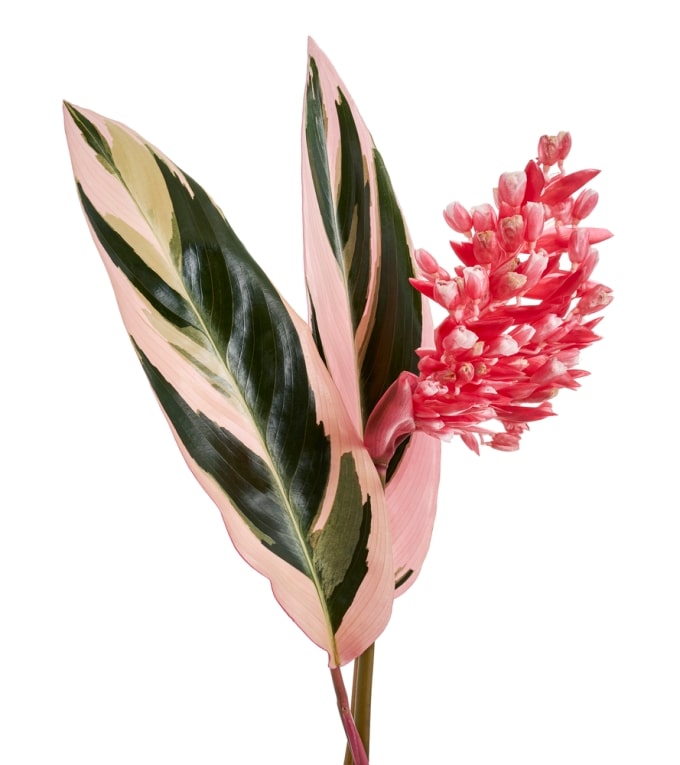If you’re looking for a vibrant plant to zhuzh up your indoor space, you might want to get acquainted with the Stromanthe Triostar! With its variegated leaves in vivid shades of pink and green, I think this plant is an absolute showstopper.
From care requirements and propagation techniques, we’ll dive into everything you need to know about the Stromanthe Triostar. I’ll even throw in some useful tips and tricks for keeping this stunning plant healthy and thriving.
So, let’s unlock the secrets to growing this gorgeous plant!
But First, A Little Background
The Stromanthe Triostar is also known as Stromanthe Sanguinea, Stromanthe Thalia, or the tricolor Stromanthe. This colorful plant with pink, green, and cream foliage is a variegated variant of the Stromanthe Sanguinea.
The Triostar, native to the lush jungle floor of Brazil, belongs to the prayer plant family (Marantaceae). Other members of this family include marantas and calatheas.
Speaking of calatheas, the Stromanthe Triostar is sometimes mistaken for its cousin. So, if you’re thinking of getting yourself a Triostar, keep an eye out for the difference between the two!
Stromanthe Triostar: What Exactly Do You Need?

Every plant has its set of challenges, and the Stromanthe Triostar is no exception. This stunning plant has quite the reputation for both its jaw-dropping look and its extreme pickiness.
However, with a little dedication and attention to its specific requirements, you can enjoy the beauty of this plant and watch it thrive in your home.
That said, here’s everything you need to know about caring for this beautiful plant:
Let’s Talk Temperature and Humidity
The Stromanthe Triostar loves temperatures ranging from 65 to 80°F, as one would expect from a tropical native Brazilian plant. This pretty girl also thrives in high humidity, so you might want to place her on your bathroom window for the best results.
Nothing could’ve prepared me for the absolute dread I felt when I spotted crisp brown leaf edges on my first Triostar. After doing some investigation, I quickly realized it was trying to tell me my space was too dry.
If you relate to this, don’t panic! Simply place your plant on a humidifying tray, which is a tray full of water and pebbles. You can also group your little one with other humidity-loving plants in your household!
If this won’t budge, I’d suggest investing in a humidifier to keep the air moist. Seriously, these things work like a charm and can help maintain the proper humidity for your tropical beleza!
Better Light Than Never!
The vibrant Stromanthe Triostar thrives in medium to bright indirect light. Ideally, placing your plant in a spot that receives 4–6 hours of dappled light every day is *chef’s kiss*.
Most importantly, never place your Triostar in direct sunlight. By doing so, you risk its vibrant colors fading.
Not to mention that the leaves on these guys are quite delicate, and direct sunlight may burn them.
What About Water?
This is by far the most crucial element for maintaining the happiness and health of your plant. It’s best to keep the soil of the Triostar moist but not soggy.
This will help you avoid the possibility of dreadful root rot. In other words, don’t spoil your plant rotten, no. In cooler temperatures, however, you can allow it to dry slightly.
How often should you water, you ask? With watering your Triostar, there’s no set schedule to follow.
Personally, I like to use the finger test. Simply stick your finger in your plant’s soil. If the top inch of the soil is dry, that means it’s time to nourish your baby with some H2O.
Speaking of H2O, make sure you use room-temperature distilled water. These guys aren’t huge fans of your average tap water, since they’re highly sensitive to chemicals.
Lastly, Soil and Fertilization
Stromanthe Triostars usually thrive in a well-draining potting mix. The soil should retain moisture, but still be airy and breathable.
For fertilizer, I like to use a diluted, balanced fertilizer every couple of weeks in the summer. Because your plant will be dormant over the winter, there’s no need to fertilize it.
Pro tip: Look for an NPK fertilizer that’s designed for indoor plants and free of urea and chlorides, two higher-salt components.
Pot It Like It’s Hot!
When potting your Triostar, the first thing you should do is check the pot depth. The depth of your container must accommodate the roots while not being excessively deep to prevent stagnant water.
Also, keep an eye out for those drainage holes, you don’t want any water-logging happening!
How the Heck Do You Propagate This Thing?

When it comes to propagation, these guys aren’t your typical stem-cutting bunch. The only way you can propagate a Triostar is through division.
I propagate mine by carefully separating the rhizomes and planting the new divisions in moist soil. For optimal results, do this in the summer or spring.
Be Gone, Pests!
One thing I noticed about my Triostars is that they’re susceptible to pests like spider mites and mealybugs.
This is why I recommend regularly inspecting your plant for any signs of infestation. You can then treat it promptly with horticultural soap or neem oil spray.
Wrapping Up
Whether you’re a seasoned plant enthusiast or just starting your indoor gardening journey, the Stromanthe Triostar is a must-have plant that’ll bring a touch of the tropics into your life.
So, why wait? Embrace the beauty of Stromanthe Triostars and unleash the wonders of a tropical oasis within your indoor space!
